Memory, FX, and the City
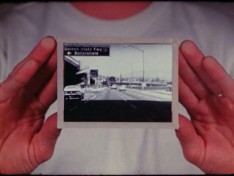
Pasadena Freeway Stills, by Gary Beydler
Los Angeles Filmforum presents
Memory, FX, and the City
Sunday April 27, 2025, 7:00pm
NOTE THE EARLY START TIME
At 2220 Arts + Archives, 2220 Beverly Blvd., Los Angeles CA 90057
Tickets: $20 for both programs today, $15 general, $10 students/seniors, free for Filmforum members
If you are interested in the $20 ticket for both programs, please use the link from the first show, Vatican to Vegas: Director’s Cut
In person discussion following the screening with Norman Klein, Courtney Stephens, Chris Peters, moderated by SeeVa Kitslis.
Los Angeles Filmforum presents Memory, FX, and the City – a short film program of seven works in conversation with Norman Klein's matinee feature and Klein's longstanding concerns. Featuring works by Deborah Stratman, Antonio Muntadas, Gary Beydler, Jacolby Satterwhite, Courtney Stephens & KJ Relth, Chris Peters and Karl Montevirgen, and Stan VanDerBeek.
Special effects illusions today invade intimacies and the body on an unprecedented scale. Once internalized, illusion is not just a scripted space but a material force confusing intimacy with the physical world. It caricatures how power, class and identity are manipulated inside us. We see this difference very much in effects films since the eighties, with globalization, with the growth of yawning economic inequalities, and with digital imperialism. Lavish 17th century Baroque techniques seemed to fit that condition somehow, in themed environments, games, movie space operas, experimental video, and cyberpunk literature. There is even a grammar in how Baroque illusion works, in how its spaces are twisted, folded, and invaded by parallel worlds. Imagine strangers climbing inside us: we feel a psychogeography of spaces that has somehow been inverted. This series of shorts is a meditation on Baroque optics today, in how evacuated memory resembles special effects. The series even captures how we misremember history. More precisely, these films highlight various psychic layers of the city, where distorted memory, and the decay of our nation state, are extremely evident. As we know, even our 2025 politics have become a special effects gimmick. Somehow, these uniquely chiseled illusions sensed 2025 in advance. They help us track down the gimmickry of power as it changes us internally.
SeeVa Dawne Kitslis is a curator and artist working in Los Angeles and Athens, Greece. SeeVa is the creator and curator of the Burns Pinon Library Collection at Burns Pinon Reserve and co-director of the Claire Trevor School of the Arts Visiting Artist Lecture series. They are the author of the artist book south facing- searching for the sun is an elusive practice and the forthcoming monograph Desert Rubble tracing illusionistic effects in art from 1 BCE to the present. Their larger artistic practice moves fluidly between the realms of the archive, architecture, information studies, and book arts—often with a deep engagement in themes of place and material memory.
Chris Peters (b. Los Angeles) earned dual degrees in film and art from the California Institute of the Arts. He teaches at CalArts and makes art and experimental film and video in Los Angeles. Exhibits include Sundance Film Festival, LA Freewaves, Michael Benevento Gallery, L.A.C.E, Torrance Art Museum, Scott Donovan Gallery, Am Nuden Da London, NY Underground, PDX Fest, CineVegas Film Fest, Cinema Texas Film Fest, NewPort Beach Film Festival, Madeira Film Festival, Cohen Leslie & Brown, Rosamund Felsen.
Courtney Stephens is a writer/director of four features and several short films. Terra Femme, composed of amateur travel footage shot by women in the early 20th century, was a New York Times critic’s pick and has toured widely as a live performance. The American Sector (with Pacho Velez) follows slabs of the Berlin Wall installed around the US. John Lilly and the Earth Coincidence Control Office (with Michael Almereyda) explores the life of psychedelics pioneer John C. Lilly, and Invention is a hybrid feature about an esoteric healing device. Her films have been exhibited at MoMA, The National Gallery of Art, The Barbican, Walker Art Center, BAMPFA, and film festivals including the Berlinale, Viennale, New Directors/New Films, Locarno, Rotterdam, Visions Du Réel, Thessaloniki, IDFA, True/False, Hong Kong, and the New York Film Festival. She is the recipient of a Guggenheim Fellowship, a Fulbright Scholarship, and grants from California Humanities, the Sloan Foundation, and the Foundation for Contemporary Art. She has co-curated the miniature cinema Veggie Cloud since 2014, and organized film programs for The Getty, Museum of the Moving Image, Flaherty NYC, and Human Resources. Her writing has appeared in BOMB, Film Comment, Filmmaker, The New Inquiry, and Cabinet.
Norman M. Klein is a critic, urban and media historian and novelist. His books include: The History of Forgetting: Los Angeles and the Erasure of Memory; Seven Minutes: The Life and Death of the American Animated Cartoon; The Vatican to Vegas: The History of Special Effects; Freud in Coney Island and Other Tales; Bleeding Through: Layers of Los Angeles, 1920-86; The Imaginary 20th Century (also an online site); Tales of the Floating Class: Essays and Fictions in Globalization and NeoFeudalism. Both The Imaginary 20th Century and Bleeding Through were pioneering “database” novels—and docufables-- that now have expanded new editions: Bleeding Through and Vatican to Vegas available online as well (from Transcript). He also has published numerous essays across the arts, architecture, cultural history; along with museum and gallery exhibitions.
Klein’s work centers on the relationship between collective memory distortion and power, especially in cities, entertainment culture, cinema and animation, within the context of national politics-- and the scientific "imaginary." He investigates histories of forgetting, ironic scripted spaces, and social imaginaries. In his docufables, he emphasizes how facts dissolve into fiction in our daily life. is now completing Archaeologies of the Present: The Dismantling of the American Psyche, on the emergent feudal condition brought on by global shocks since 1973. As Klein often points out in lectures, progress keeps running off the rails, but we must avoid any form of nihilism, now more than ever.
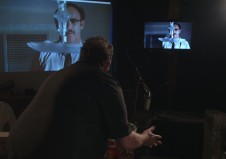
Hacked Circuit
Hacked Circuit
Directed by Deborah Stratman
2014, digital, color, sound, 15 min.
A single-shot, choreographed portrait of the Foley* process, revealing multiple layers of fabrication and imposition. The circular camera path moves inside and back out of a Foley stage in Burbank, California. While portraying sound artists at work, typically invisible support mechanisms of filmmaking are exposed, as are, by extension and quotation, governmental violations of individual privacy.
The scene being foleyed is the final sequence from The Conversation, where Gene Hackman’s character Harry Caul tears apart his room searching for a ‘bug’ that he suspects has been covertly planted. The look of Caul’s apartment as he tears it apart mirrors the visual chaos of the Foley stage. This mirroring is also evident in the dual portraits of sonic espionage expert Caul and Foley artist Gregg Barbanell, for whom professionalism is marked by an invisibility of craft. And in the doubling produced by Hackman’s second appearance as a surveillance hack, twenty-four years later in Enemy of the State.
These filmic quotations ground Hacked Circuit, evoking paranoia, and a sense of conviction alongside a lack of certainty about what is visible. The complication of the seen, the known, the heard and the undetectable provides thematic parallels between the stagecraft of Foley and a pervasive climate of government surveillance. – Video Data Bank
Media Hostages: S.S.S.
Directed by Antonio Muntadas
1985, digital, color, sound, 6:24 min
In December of 1984, a "living" billboard was erected on Sunset Boulevard in Los Angeles as a promotion for a line of jewelry. A group of aspiring actors took up residence on it, each competing to outlast the others and win a screen test. Artists Chip Lord, Branda Miller and Antonio Muntadas collaborated to produce three views of this public spectacle, creating a work collectively titled Media Hostages. Muntadas' S.S.S. is a personal, visual commentary using the billboard as a "Media Case" in the larger context of America, circa 1985. – Electronic Arts Intermix
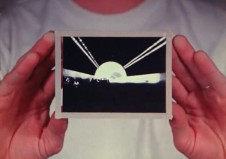
Pasadena Freeway Stills
Pasadena Freeway Stills
Directed by Gary Beydler
1974, 16mm, color, silent, 16:00 min
"I had one of my graduate students drive the car, and I filmed 16mm black and white negative driving through these four consecutive tunnels on the Pasadena freeway. I wound up doing about 1400 paper prints from the individual frames in the negative. I mounted a piece of glass in my garage, with a square of tape marked out on it. I sat down behind the glass with a white T-shirt on and started shooting the stills. My wife Sarah shot the first part, and as the shots got shorter and shorter, I shot it myself using a bulb hooked up to the camera that I operated with my foot. I originally meant to shut it off and fade it out to end it, but while I was shooting, I decided instead to reverse the procedure, slowing the shots back down. I called Sarah back to shoot the last part. I always had the idea of sound, but I could never figure out what the heck kind of sound to have in this film." (Gary Beydler, 2008)
"Possibly the most lucid, vivid, and awesome demonstration of the building up of still images to create moving ones, Pasadena Freeway Stills simply, gracefully and powerfully shows us the process by which we are fooled by the movies. By doing so, Gary Beydler mines a very rich vein of associations and metaphor, without the slightest ostentation.
"Constructed as a thrilling arc of realization and, in a quite moving way, disappointment, the film is a beautiful articulation of our emotional entanglement with moving images, while simultaneously creating a form in which the illusion of cinema is brought into incredible relief as the film we're watching gradually catches up to the film Gary is holding up to the camera with his hands, one frame at a time." (Mark Toscano)
Country Ball, 1989-2012
Directed by Jacolby Satterwhite
2012, digital (HD video), color, sound, 12:38 min.
In The Country Ball, Satterwhite fuses drawing, live performance and digital technology to translate and document personal mythology. Here the artist's sources are a home video of a family cookout and his mother's drawings. Hand-tracing the drawings and importing them into a 3D animation program, Satterwhite builds a lush, computer-generated landscape. Performing in front of the camera and "green screen" 100 times, he inserts his dance performances into the virtual space to create what he terms "a Hieronymous Bosch 'Garden of Earthly Delights' inspired landscape."
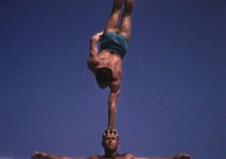
Mating Games
Mating Games
Directed by Courtney Stephens & KJ Relth
2017, 16mm, color, 8 min (Courtney & KJ?)
All archival film made from Muscle Beach home movies
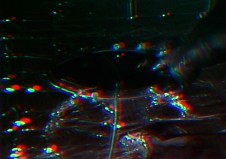
SpaceCaptainScurvy: Scurvy @ the Threshold,
SpaceCaptainScurvy: Scurvy @ the Threshold,
Directed by Chris Peters and Karl Montevirgen
2024, digital, color, sound, 4.34 min
World Premiere!
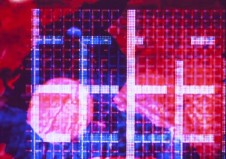
Poemfield No. 5
Poemfield No. 5
Directed by Stan VanDerBeek,
1967, 16mm or digital, color, silent, 7 min.
COMPUTER ART SERIES is animated computer/graphic films. The series is called POEMFIELD. All of these films explore variations of poems, computer graphics, and in some cases combine live action images and animation collage; all are geometric and fast moving and in color. There are eight films in the computer animated art series. As samples of the art of the future all the films explore variations of abstract geometric forms and words. In effect these works could be compared to the illuminated manuscripts of an earlier age. Now typography and design are created at speeds of 100,000 decisions per second, set in motion a step away from "mental movies." POEMFIELD No. 2 and 5 are all colorized by Brown and Olvey. – Canyon Cinema
